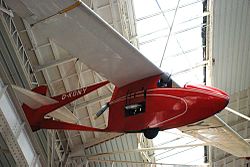Raab crow
| Raab crow | |
|---|---|
 D-KONY in the Technik-Museum Speyer |
|
| Type: | Motor sailer |
| Design country: | |
| Manufacturer: |
Amateur construction , rock glider construction , Inzell, Obb. |
| First flight: |
June 10, 1957 |
| Production time: |
1957 to? |
| Number of pieces: |
30th |
The Raab Krähe is a motor glider designed by Fritz Raab and intended for amateur construction , which was also produced in series by the German manufacturer Rock Segelflugzeugbau .
history
The "Krähe" was developed by Fritz Raab in the tradition of the previous glider design Doppelraab and the motor glider test models Motorraab and Dohle with the assistance of the flight engineering firm Gerhard Siegel in Gauting . A set of 53 drawings existed for the group replication as part of the amateur construction, whereby the J. Rock glider construction in Inzell also provided the corresponding kit parts.
The crow was developed from the beginning as a self-launching motor glider, whereby the sailing skills should correspond to those of a good practice sailor. The second design premise was to achieve a robust and simple structure and thus also good reproducibility in flight groups. The basic construction work was completed in 1957 and on June 10 of the same year the first prototype with the registration D-EGAZ took off on its maiden flight . A Goggo motor 400 was used as the engine .
The second prototype differed only in the installation of a Brändl ZB 300 engine and flew for the first time in 1958. The third prototype was presented at the World Gliding Championships in Cologne-Butzweilerhof in 1960 . The fourth prototype first flew at the motor glider meeting in Augsburg in 1959 as a pure glider, but later also received the Brändl engine. Since this type of engine did not have a cooling fan when it was installed, large cooling air funnels were necessary. Only the fifth prototype received a Brändl motor with a corresponding cooling fan and thus corresponded to the series version.
The crow was self-starting from an engine output of 16 hp, but engines with up to 40 hp and 75 kg weight could be installed. A larger power could not be used because of the limited propeller diameter of 1.32 m.
construction
The crow is a cantilever monoplane in wood construction . The three-part wing has a spar . The wing center section has a rectangular shape, the trapezoidal outer wing parts have a V-position and carry one-piece ailerons over almost the entire trailing edge . The fuselage has a very simple structure with a boat-shaped front part and a flat tail unit that is braced with four steel cables to the wing's trailing edge. The engine is installed behind the pilot's seat and drives a rigid two-bladed wooden propeller . The propeller runs between the upper and lower chords of the tail boom.
The chassis consists of a central wheel in front of the center of gravity and a rear runner. The pilot's seat is in front of the wing leading edge and is covered by a hood.
Technical specifications
| Parameter | Data |
|---|---|
| crew | 1 |
| length | 6.70 m |
| span | 12.00 m |
| Wing area | 14.38 m² |
| Wing extension | 10.2 |
| Glide ratio | 20th |
| Slightest sinking | 0.95 m / s |
| Empty mass | 220 kg |
| Max. Takeoff mass | 340 kg |
| Cruising speed | 90 to 95 km / h |
| Top speed | 120 km / h |
| Engines | 1 × Zink-Brändl ZB 300 fan-cooled two - cylinder two - stroke engine with 18 HP starting power. |
See also
literature
- Karlheinz Kens: Airplane types - type book of international aviation , 4th edition, Carl Lange Verlag, Duisburg, 1963
Web links
- Photo of the crow with the registration number D-KORL in the Oberschleissheim Museum
- Rock glider construction
